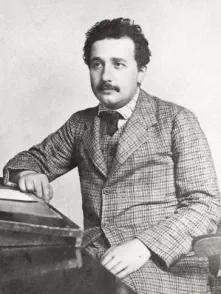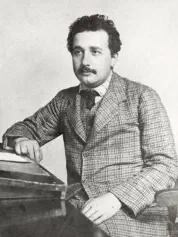


In 1905, Albert Einstein had four papers published in scientific journals, each of which was of such significance that the
year is sometimes referred to as the annus mirabilis – the “miracle year”. The subjects were:
Einstein’s Special Relativity and E = mc
2
Papers

And E = mc
2
Paper
Special Relativity Paper
The photoelectric effect - demonstrating that a beam of electromagnet radiation, such as light, is
composed of small particles now called photons, each with a particular amount - or “quanta” - of energy.
This is one of the foundations of quantum physics, and therefore quantum mechanics.
Brownian motion - It had long been known that small particles, such as pollen grains, displayed erratic
behaviour when floating in a fluid such as water. Einstein’s paper demonstrated that this was due to the
movement of atoms in the fluid acting in a way similar to billiard balls, colliding with the pollen grains and
causing them to move in erratic paths and with varying speeds. This was the first solid theoretical
evidence for the existence of atoms.
Special relativity - This paper redefined space and time into a single entity, called space-time. It was
demonstrated that it’s impossible to move in space without moving in time. In particular, the faster a
body moves the more its internal clock slows as observed by a stationary observer. This page gives a
quick and easy overview of the subject.
E = mc
2
- In this paper, Einstein demonstrated that anything with mass has energy locked up in it, which
under certain conditions can be released - therefore mass and energy are different manifestations of the
same thing. A quick overview is given on the page E = mc
2
- The Basics.
English translations of the papers for Special Relativity and E = mc
2
are available below. However, it’s
recommended that the points below the downloadable PDF files are considered when viewing the papers:





The first paper in particular is complex and requires a reasonably high level of
mathematical fluency, therefore the implications may not be clear or obvious. The
papers had little impact on first publication in 1905. Einstein was still a patent clerk
at an office in Switzerland and had very limited access to the resources and
collaboration found in academic and research departments. The significance of
the papers was only slowly realised even within the physics community.
This changed dramatically when a 1919 experiment involving a total solar eclipse
provided strong evidence for his later General Theory of Relativity, by correctly
predicting the bending of light around massive objects, such as the Sun. This in
turn provided evidence for the earlier paper outlining Special Relativity, of which
Einstein’s General Relativity paper, first published in 1915, can be considered an
extension.
The second, much shorter, paper formulates E = mc
2
and can be considered an
addition to the Special Relativity paper.
One other point to note is that some of the mathematics used in the papers is now
considered archaic, and this again makes the papers sometimes difficult to follow.
Much has changed in mathematics since 1905 as new techniques have been
employed and more efficient mathematical methods discovered.

Click or tap on the PDF documents to view or download.

This page is concerned with the last two papers.
The papers
Points to note:

Einstein in around 1902, while still
a patent clerk in Bern, Switzerland
Advertisement


Advertisement


And E = mc
2
Paper
Special Relativity Paper
Einstein’s Special Relativity and E = mc
2
Papers
In 1905, Albert Einstein had four papers published in scientific
journals, each of which was of such significance that the year is
sometimes referred to as the annus mirabilis – the “miracle year”.
The subjects were:




The Special Relativity and E = mc
2
Papers
English translations of the papers for Special Relativity and E =
mc
2
are available below. However, it is recommended that the
points below the downloadable PDF files are considered when
viewing the papers:


Click or tap on the PDF documents to view or download.
Points to note:

Einstein in around 1902, while still
a patent clerk in Bern, Switzerland
The photoelectric effect - demonstrating that a beam of
electromagnet radiation, such as light, is composed of
small particles now called photons, each with a particular
amount - or “quanta” - of energy. This is one of the
foundations of quantum physics, and therefore quantum
mechanics.
Brownian motion - It had long been known that small
particles, such as pollen grains, displayed erratic
behaviour when floating in a fluid such as water.
Einstein’s paper demonstrated that this was due to the
movement of atoms in the fluid acting in a way similar to
billiard balls, colliding with the pollen grains and causing
them to move in erratic paths and with varying speeds.
This was the first solid theoretical evidence for the
existence of atoms.
Special relativity - This paper redefined space and time
into a single entity, called space-time. It was
demonstrated that it’s impossible to move in space
without moving in time. In particular, the faster a body
moves the more its internal clock slows as observed by a
stationary observer. This page gives a quick and easy
overview of the subject.
E = mc
2
- In this paper, Einstein demonstrated that
anything with mass has energy locked up in it, which
under certain conditions can be released - therefore
mass and energy are different manifestations of the
same thing. A quick overview is given on the page E =
mc
2
- The Basics.
The first paper in particular is complex and requires a reasonably
high level of mathematical fluency, therefore the implications may
not be clear or obvious. The papers had little impact on first
publication in 1905. Einstein was still a patent clerk at an office in
Switzerland and had very limited access to the resources and
collaboration found in academic and research departments. The
significance of the papers was only slowly realised even within the
physics community.
This changed dramatically when a 1919 experiment involving a
total solar eclipse provided strong evidence for his later General
Theory of Relativity, by correctly predicting the bending of light
around massive objects, such as the Sun. This in turn provided
evidence for the earlier paper outlining Special Relativity, of which
Einstein’s General Relativity paper, first published in 1915, can be
considered an extension.
The second, much shorter, paper formulates E = mc
2
and can be
considered an addition to the Special Relativity paper.
One other point to note is that some of the mathematics used in
the papers is now considered archaic, and this again makes the
papers sometimes difficult to follow. Much has changed in
mathematics since 1905 as new techniques have been employed
and more efficient mathematical methods discovered.

















